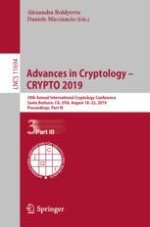2019 | OriginalPaper | Buchkapitel
Statistical Zeroizing Attack: Cryptanalysis of Candidates of BP Obfuscation over GGH15 Multilinear Map
verfasst von : Jung Hee Cheon, Wonhee Cho, Minki Hhan, Jiseung Kim, Changmin Lee
Erschienen in: Advances in Cryptology – CRYPTO 2019
Aktivieren Sie unsere intelligente Suche, um passende Fachinhalte oder Patente zu finden.
Wählen Sie Textabschnitte aus um mit Künstlicher Intelligenz passenden Patente zu finden. powered by
Markieren Sie Textabschnitte, um KI-gestützt weitere passende Inhalte zu finden. powered by
